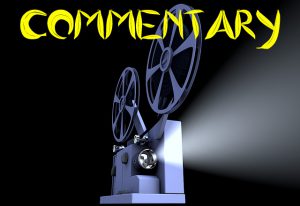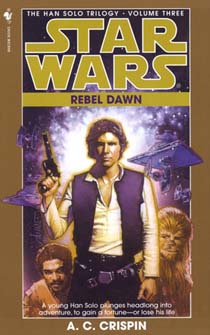“Rebel Dawn” (1998) wraps up the best and most essential “Star Wars” trilogy outside of the classic films. Honestly, although its difficult to make a cross-media comparison, I think A.C. Crispin’s telling of Han Solo’s backstory is better than George Lucas’ telling of Anakin Skywalker’s backstory.
It’s a combination of the sheer coolness of experiencing key elements of Han’s formative years — his winning of the Millennium Falcon from Lando in a game of sabacc — and surprising revelations that make sense in retrospect. After reading about Bria’s betrayal of Han here, you’ll never hear “I’m not in this for the Rebellion and I’m not in it for you, sweetheart, I’m in it for the money” the same way again. I was practically screaming at the pages just as the betrayed Han was screaming at Bria. Although the evil of the Empire is never in question in Crispin’s work, we see a not-so-savory side of the Rebellion in “Rebel Dawn” as well: Bria hires smugglers to help her in the battle of Ylesia, then steals their shares of the spoils. While finding out your government is corrupt is bad enough, learning that the revolutionaries are also corrupt makes disillusionment seem like the only rational course.
Continuing from “The Hutt Gambit,” another thing Crispin does so well here is reference other “Star Wars” works and tie everything together smoothly. Granted, there is a slight “rush to the finish” feel to the final chapters as we see Han make his famous Kessel Run; make enemies of former boss Jabba, former friend Lando and former lover Salla Zend (for different reasons, none of which are his fault, of course); and end up in the cantina for his debut film performance. How about the idea that Bria is killed on the mission on Toprawa (chronicled in the “Star Wars” radio drama) to pass the Death Star plans on to Princess Leia? I guess I’ll buy it; Crispin has earned the benefit of the doubt by this point.
Crispin also does a nice job addressing an out-of-universe “Star Wars” criticism: The notion that Han’s claim of making the Kessel Run in less than 12 parsecs is inaccurate because a parsec is a measure of distance, not speed. Because space bends around black holes, the distance from point A to point B in space can change. Han, looking at the Millennium Falcon’s instruments, addresses Chewbacca on page 370:
“Hey, this is weird. It says we actually shortened the distance we traveled, not just the time. Less than 12 parsecs!”
To make sense of this in Earth terms, imagine that you’re on a cross-country challenge to make it from point A to point B in the fewest amount of miles. In such a test, you would look for roads that form the straightest line, not roads that allow the fastest speeds. To follow this metaphor: Han took a dangerous back road on the Kessel Run in order to set the record.
The author’s neatest trick is that she squeezes all three of Brian Daley’s “Han Solo Adventures” into the narrative, using Han’s rocky relationship with Salla (as mentioned when they meet again in “Dark Empire”) as the springboard for his dash to the Corporate Sector. A lot of Crispin’s trilogy writes itself, in the sense that she takes backstory events from future stories, puts them onto a timeline and then brings them to life in a logical way. Other elements and characters — notably Bria — are wholly Crispin’s. But, aside from a few moments where you’ll inevitably guess what’s going to happen, it all flows together so well.

If screenwriter Lawrence Kasdan and the makers of the young Han Solo prequel movie want to ignore Crispin’s novels, well, that’s their prerogative, I guess. As for topping what Crispin did as a storyteller — well, I’ll quote Han Solo from Kasdan’s own “Return of the Jedi”: “Good luck. You’re gonna need it.”

